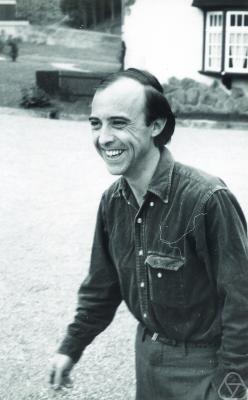Bill Parry (mathematician) facts for kids
Quick facts for kids
William Parry
|
|
|---|---|

Parry at Oberwolfach in 1968
|
|
| Born | 3 July 1934 Coventry, Warwickshire, England
|
| Died | 20 August 2006 (aged 72) Marton, Warwickshire, UK
|
| Alma mater | University College London University of Liverpool Imperial College London |
| Occupation | Mathematician |
| Known for | Ergodic theory and dynamical systems |
| Title | Professor of Mathematics Fellow of the Royal Society |
| Spouse(s) |
Benita Teper
(m. 1958–2006) |
| Children | 1 |
| Scientific career | |
| Institutions | Birmingham University University of Sussex University of Warwick |
| Thesis | Ergodic and mixing transformations (1960) |
| Doctoral advisor | Yael Dowker |
| Doctoral students | Mark Pollicott Mary Rees |
William Parry (3 July 1934 – 20 August 2006) was an English mathematician. He was a Fellow of the Royal Society, a very important group of scientists. He studied how things change and move over time. This area of math is called dynamical systems. He also worked in ergodic theory, which looks at the long-term behavior of these systems.
Contents
Life Story
Early Life and Education
Bill Parry was born in Coventry, England, in 1934. He was the sixth of seven children in his family. When he was young, he did not pass an important school test called the Eleven plus exam.
However, his math teacher at Coventry Junior Technical School saw his talent. This teacher encouraged him to go to university. To prepare, Bill had to travel to Birmingham Technical College for extra lessons.
He then earned a spot at University College London. After getting a master's degree from the University of Liverpool, he went back to London. He studied at Imperial College London with a teacher named Yael Dowker. He earned his PhD in 1960. His main research paper was about "Ergodic and mixing transformations."
Becoming a Professor
Bill Parry taught at Birmingham University and the University of Sussex. In 1968, he joined the new University of Warwick as a senior teacher. He was the first person hired there to teach a type of math called analysis.
Two years later, in 1970, he gave a very popular speech. This was at a big meeting for mathematicians in Nice, France. After this, he became a full professor.
He played a big part in building the math department at Warwick. He was even the head of the department for two years. The department became known worldwide because of people like Bill Parry.
Later Years and Legacy
In 1984, he was chosen to join the Royal Society. This showed how important his math work was. But he usually did not use the title "Fellow of the Royal Society." He only used it when it could help a cause he cared about.
Bill Parry kept teaching and helping others learn math. He taught a university course on ergodic theory until 2003. This was just a few years before he passed away.
He wrote more than 80 research papers and four books. Some of his students became famous mathematicians too. These included Mark Pollicott and Mary Rees.
Bill Parry died in Marton, Warwickshire, in 2006. He was 72 years old and passed away after an illness.
Research Work
In 1975, Bill Parry and another mathematician, Dennis Sullivan, created a special mathematical idea. It is called the Parry–Sullivan invariant. This idea helps mathematicians understand how things change in one-dimensional systems.
See also
- Parry–Daniels map
- Parry–Sullivan invariant
- Parry measure

